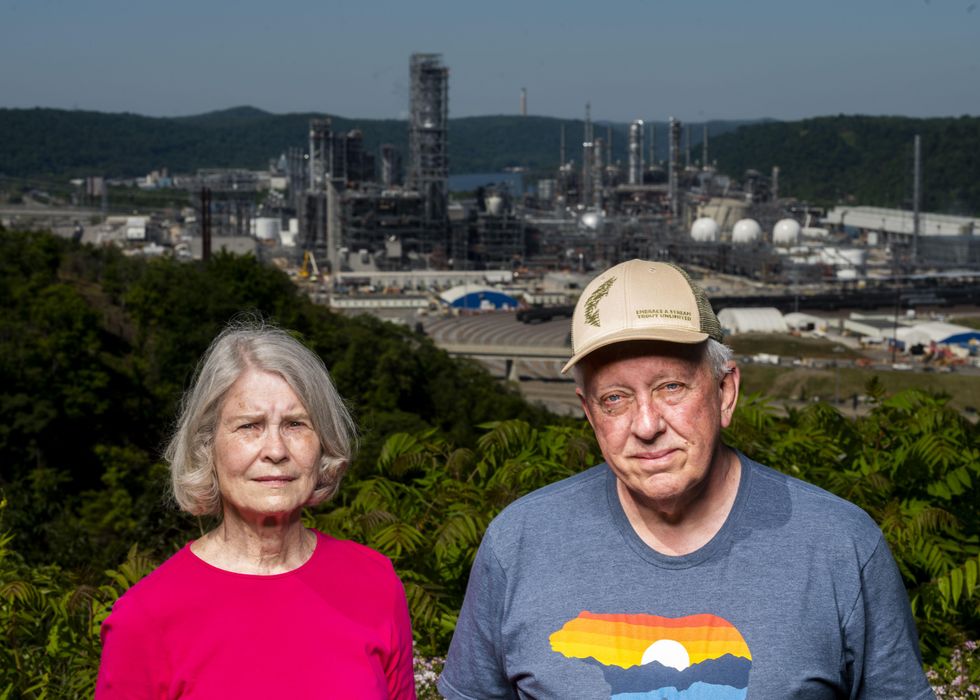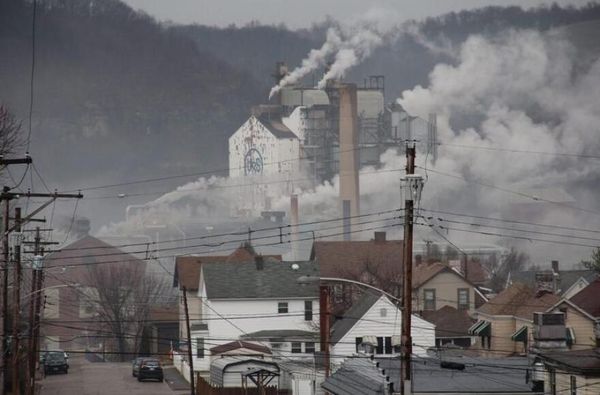Our zip codes are more important than our genetic codes in predicting our overall health and lifespans.
Pittsburgh and southwestern Pennsylvania face unique environmental health challenges. This guide explores those challenges and how you can help address them.
What is environmental health?
Environmental health is the relationship between human health and our environment.
The field of environmental health is a branch of public health that looks at the health effects of everything from air pollution and water contamination to toxic chemicals in consumer products and climate change.
These issues impact the health, wellbeing and longevity of people who live in some places more than others — including Pittsburgh and southwestern Pennsylvania.
Why is environmental health important in Pittsburgh and southwestern Pennsylvania?
Pittsburgh and southwestern Pennsylvania have long been home to extractive and manufacturing industries that substantially impact the environment and human health.
Long ago the region was home to the lumber industry, then some of the world’s first oil wells and coal mining, then steel mills, and now natural gas extraction and petrochemical plants.
Many cities, towns and neighborhoods throughout southwestern Pennsylvania were populated and built around these industries, so local politics historically have been led or heavily influenced by industry insiders. This resulted in policies that prioritize industrial growth, often at the expense of the environment and human health. The effects of these practices and policies still linger today.
The region also features unique topography with plentiful mountains and valleys that influence the way pollutants move through the environment (or don’t) and who is most impacted by them.
What this guide will cover
Air pollution in Pittsburgh and southwestern Pennsylvania
- Health impacts
- Sources of air pollution
Water contamination in Pittsburgh and southwestern Pennsylvania
- Health impacts
- Sources of water contamination
Climate change in Pittsburgh and southwestern Pennsylvania
- Effects
- Health impacts
Environmental justice in Pittsburgh and southwestern Pennsylvania
Solutions to environmental health problems in Pittsburgh and southwestern Pennsylvania
Air pollution in Pittsburgh and southwestern PA
During the steel industry’s heyday, the air in Pittsburgh was so polluted it looked dark during the daytime.
The region’s air has improved drastically since the federal Clean Air Act was enacted in 1970. But southwestern Pennsylvania still regularly sees some of the most polluted air in the country.
What Pittsburgh and southwestern Pennsylvania’s air pollution problems mean for our health:
- Higher cancer risk
- Allegheny County is in the top 2% of all U.S. counties for cancer risk from air pollution
- Pennsylvania has the third highest cancer rate of all U.S. states, and Pittsburgh and surrounding regions have higher than state average rates of certain types of cancer — particularly those associated with exposure to pollution, including:
- Lung cancer
- Colon cancer
- Breast cancer
- Bladder cancer
- Non-Hodgkin lymphoma.
- A 2021 study estimated that even if everyone in Allegheny County had quit smoking 20 years ago, lung cancer rates would only be 11% lower, further suggesting that pollution plays a significant role in the region’s lung cancer rates.
- For contrast, in the other 612 counties throughout the U.S. included in the study, lung cancer rates would have dropped an average of 62% if everyone had quit smoking 20 years ago.
- Asthma and other respiratory diseases
- Exposure to air pollution can cause childhood asthma, which is a huge problem in Pittsburgh
- In Pittsburgh’s most polluted neighborhoods, elementary schools have asthma rates as high as 42%—more than five times as high as the national rate
- A study of 1,200 elementary school students in Pittsburgh’s most polluted neighborhoods found that more than 70% of kids live in areas with air pollution levels that exceed World Health Organization guidelines
- Air pollution is also an important risk factor for other respiratory diseases, like chronic obstructive pulmonary disease, which impacts more than 70,000 residents of Allegheny County
- From 2011 to 2017 (the most recent data available), COPD or asthma among older adults represented the highest rate of preventable emergency room visits in Allegheny County.
- Heart disease
- Air pollution is a key risk factor for cardiovascular health
- Heart disease is the leading cause of death in Allegheny County, and the county’s rate of death from heart disease is higher than the state average.

Bryan (left) and Ryan Latkanich (right) in front of their Fredericktown, Pennsylvania, home. Bryan has been fighting the fracking industry for years over pollution near his home.
Credit: Connor Mulvaney for Environmental Health News
- Mental illness
- Worrying about air pollution can cause stress or anxiety, but exposure to air pollution can also physically alter our brains in ways that increase the risk of mental illness
- From 2018 to 2020, 40% of adults in Allegheny County reported having one or more days where their mental health was "not good”
- These figures were higher in Allegheny County than in half of other Pennsylvania counties, and slightly higher than state averages.
- The town of Clairton, about 15 miles south of Pittsburgh, is in the worst 25% of U.S. cities for the percentage of adults experiencing 14 or more days of poor mental health each month.
- Clairton has particularly dirty air caused by emissions from a U.S. Steel plant.
- Autism
- Exposure to air pollution is linked to increased risk of autism spectrum disorder in children.
- In Allegheny County, the number of people with autism doubled from 2005 to 2011.
- Exposure to air pollution is linked to increased risk of autism spectrum disorder in children.
- Neurological disorders
- Exposure to air pollution is also linked to Parkinson’s disease, Alzheimer’s disease and dementia in older adults.
- Pregnancy complications
- Exposure to air pollution has been linked to pregnancy complications like preeclampsia, gestational hypertension and premature birth in general, and in Allegheny County specifically.
- Premature death.
- Exposure to air pollution is linked to increased risk of premature death (dying before the age of 75).

Terrie Baumgardner and Bob Schmetzer of the advocacy group Beaver County Marcellus Awareness Community.
Nate Smallwood for Environmental Health News and Sierra Magazine
Sources of continued air pollution in Pittsburgh and southwestern Pennsylvania include:
- Industrial emissions
- The Pittsburgh region is home to a number of large scale polluters.
- Just 10 industrial sites emit 60% of industrial air pollution in Allegheny County, according to the environmental advocacy group PennEnvironment.
- Clean air advocates have long complained that the region operates under a “pay to pollute” model.
- This means the fines companies receive for breaking clean air laws are so small that it’s cheaper to pay them than it would be to stop.
- For example, U.S. Steel was fined $1.8 million for pollution from the Clairton Coke Works in 2022. This is equivalent to a fine of $15.68 for a typical Pittsburgh household earning the 2019 median income of $48,711 — substantially less than a parking ticket.
- The Pittsburgh region is home to a number of large scale polluters.
- Oil and gas emissions
- Pennsylvania is second only to Texas in U.S. natural gas production, with much of the extraction in southwestern Pennsylvania
- The fracking industry emits around 5,648 tons of volatile organic compounds and more than 100,000 tons of methane every year
- Pennsylvania has no state laws regulating these types of emissions from oil and gas sources. Republican lawmakers have blocked recent efforts to change that.
- Exposure to emissions from oil and gas wells have been linked to a range of health impacts, from skin and respiratory irritation to organ damage and increased cancer risk
- A 2021 study by EHN found that families living near fracking wells in southwestern Pennsylvania are exposed to harmful chemicals through air pollution
- This was the first time anyone had looked at the levels of these chemicals in children living near fracking wells
- One nine-year old boy had markers for harmful chemicals in his body levels 91 times the national average
- Living near oil and gas wells also impacts mental health.
- Conventional oil and gas wells, both active and abandoned, also contribute substantially to the region’s air pollution problems, in addition to hastening climate change.
- Traffic emissions.
- Emissions from non-electric vehicles — particularly those that use diesel fuel— contribute to air pollution in significant ways
Water contamination in Pittsburgh and southwestern PA
The quality of surface water and drinking water also influence the environmental health of a population.
Pittsburgh and southwestern Pennsylvania have had longstanding issues with contaminated waterways, lead pipes and aging infrastructure. The region, like much of the U.S., also has problems with PFAS (per- and polyfluoroalkyl substances).
What Pittsburgh and southwestern Pennsylvania’s water pollution problems mean for our health:
- Higher cancer risk
- A national study on drinking water in 2019 found cancer-causing chemicals in Pittsburgh's drinking water, including some at levels three times the national average
- The same study estimated that carcinogens in drinking water cause up to 100,000 cancer cases in the U.S.
- Higher risk of learning disabilities
- No amount of lead exposure is safe, and lead exposure is linked to learning disabilities in children
- Higher risk of mental illness
- Emerging research suggests that childhood lead exposure can also lead to mental health impacts later in life
- Kids born in the 1970s experienced widespread exposure to high levels of lead during childhood due to leaded gasoline.
- In Allegheny, Butler, Washington, and Westmoreland counties—the four most populated counties in western Pennsylvania—there are around 371,656 people between the ages of 40 and 54 who likely experienced high levels of lead exposure as children and may now be experiencing mental health impacts as a result
- Subsequent generations of western Pennsylvanians have also been exposed to lead during early childhood through water contamination.
- Increased risk of other diseases from exposure to PFAS
- Exposure to PFAS is linked to health problems including kidney and testicular cancer, liver and thyroid problems, reproductive problems, pregnancy-induced high blood pressure, low birthweight, increased risk of birth defects, changes in cholesterol levels and hormones, and lower vaccine effectiveness in children.
- Risk of acute illness for vulnerable populations
- Certain groups are more likely to get sick from bacterial contaminants in drinking water, including infants, young children, people who are pregnant, older adults and people with weakened immune systems like those living with HIV, undergoing chemotherapy or taking transplant medications.
- Risk of illness or infection from contact with waterways during sewage overflows .
- Contact with sewage-contaminated waterways exposes people to E. coli and fecal coliform bacteria, which can cause infections and flu-like symptoms.

Downtown Pittsburgh at The Point, where the Ohio, Allegheny, and Monongahela Rivers converge.
Credit: Kristina Marusic
Sources of water contamination in Pittsburgh and southwestern Pennsylvania include:
- Lead pipes
- Despite recent progress on replacing lead pipes, lead was detected in 80% of Allegheny County water systems in 2019
- Lead levels in the Pittsburgh Water and Sewer Authority's water rose steadily from 1999 to 2016
- Because of inconsistent testing, the region's water could have had dangerously high levels of lead contamination for years before it was caught during the city's infamous "lead crisis"
- In 2016, 18 Pennsylvania cities including Pittsburgh, Altoona, Johnstown and Erie had higher levels of lead exposure among children than those seen in Flint, Michigan, at the height of its lead crisis
- Allegheny County didn't mandate universal blood lead screening for kids until 2018, so it's difficult to assess just how widespread lead exposure was during that time period.
- The oil and gas industry
- Local waterways and drinking water are contaminated with radioactive substances and other toxic chemicals from the oil and gas industry
- Agricultural and mining runoff
- More than a third of Pennsylvania’s waterways are impaired in some way, largely due to chemical agricultural runoff and acid drainage from abandoned mines.
- Industrial sites
- A 2018 report ranked Pennsylvania second-worst in the nation for industrial pollution in waterways
- Several of the most-polluting industrial sites in the state are located in southwestern Pennsylvania
- PFAS contamination sites
- PFAS contamination often occurs near airports, military bases and industrial sites. The contaminants have impacted drinking water in a number of southwestern Pennsylvania communities including Moon Township, Coraopolis, Neville Island and Mckeesport
- There’s also evidence that PFAS used during fracking is impacting drinking water in rural southwestern Pennsylvania.
- Sewage overflows.
- An estimated 15 billion gallons of sewage-laden stormwater is released into Pittsburgh’s three rivers each year due to aging and inadequate infrastructure.
Climate change in Pittsburgh and southwestern PA

Youth climate protest 2019 in downtown Pittsburgh.
Credit: Kristina Marusic
The impacts of the climate crisis are being felt the world over, and Pittsburgh and southwestern Pennsylvania are no exception.
Climate change impacts in Pittsburgh and southwestern Pennsylvania include:
- Flooding
- The Pittsburgh region has seen increasingly wet rainfalls and severe flooding, with more expected as climate change progresses
- More flooding creates additional challenges for the region’s aging infrastructure.
- Extreme weather events
- Record snow and rainfall, extreme heat, tornadoes and tropical storm flooding are on the rise in the region.
- Increases in disease-carrying insects.
- Climate change has led to increased populations of disease-carrying insects in Pennsylvania, including ticks and mosquitoes.
What climate change in Pittsburgh and southwestern Pennsylvania means for our health:
- Loss of housing and increased numbers of unhoused residents
- Extreme weather and energy insecurity driven by climate change increase the risk of homelessness
- Pittsburgh is experiencing a growing homelessness crisis
- Unhoused people are also at greater risk of harmful impacts from extreme weather events driven by climate change.
- Increased risk of insect-borne diseases
- There have been numerous cases of western Pennsylvanians getting West Nile virus in recent years
- Lyme disease is on the rise in western Pennsylvania.
- Threats to children’s health.
- Children face disproportionately high risk of disease and harm from climate change.
Environmental injustice in Pittsburgh and southwestern PA
In Pittsburgh and western Pennsylvania, as with other parts of the country, racist practices like Jim Crow laws and redlining resulted in communities of color being exposed to higher levels of health-harming pollution.
These policies are outlawed today, but low-income communities and people of color in Pittsburgh and southwestern Pennsylvania are still exposed to more pollution than their white counterparts as a result of those historically racist policies. The idea that these types of wrongs should be righted is referred to as environmental justice.
Environmental injustice issues in Pittsburgh and western Pennsylvania include:
- Higher rates of death from air pollution among lower-income and racial minority residents
- Higher rates of asthma among Black residents
- Blood lead levels in Allegheny County are declining overall, but not equitably: The percentage of children of color with confirmed elevated blood levels is six times greater than the percentage of white children with elevated blood lead levels
- The overlapping impacts of environmental and racial injustice lead to substantially worse public health outcomes for communities of color in Pittsburgh and southwestern Pennsylvania.

Jeff Bryant and his daughter, Cheyenne, live in Marianna, one of the most heavily fracked counties in Pennsylvania. Cheyenne tested positive for biomarkers of exposure to toxic chemicals.
Photos by Nate Smallwood for Environmental Health News and Sierra Magazine
Solutions to environmental health problems in Pittsburgh and southwestern PA
These problems can feel overwhelming, but there are lots of groups working toward meaningful solutions — and they’re having some big wins.
Local researchers are seeking out better ways to monitor air pollution. Local students are advocating for renewable energy in their school districts. And residents are acting as effective watchdogs for major polluters, to name just a few examples.
We can all be part of those solutions by supporting the efforts that are already underway. Simple ways to do this include donating time or money to the organizations doing this work and signing up for their newsletters and/or following them on social media so it’s easy to respond to and share their calls to action when important legislation or decisions are at stake.
We can also let our local elected officials know that addressing these environmental health issues is a top priority for their constituents.
Who oversees air quality in Pittsburgh and southwestern PA?
- Allegheny County: The Allegheny County Health Department and County Executive Rich Fitzgerald, who oversees the Health Department
- Surrounding regions: The Pennsylvania Department of Environmental Protection and the U.S. Environmental Protection Agency (EPA)

Contacting key decision makers
- Reach out to the Allegheny County Department of Health with specific air quality complaints, and ask county executive Rich Fitzgerald to prioritize improving the region’s air quality by strictly enforcing clean air laws
- Contact your local and state lawmakers via email, phone calls and/or social media to let them know that improving our air quality is a priority for their constituents.
- Contact polluters
- You can also directly contact major industrial polluters in our region via email, phone and/or social media to tell them their pollution is harming our health.
Organizations advocating for cleaner air and environmental justice in Pittsburgh and southwestern Pennsylvania:
- Allegheny County Clean Air Now
- Breathe Project
- Clean Air Council
- Group Against Smog and Pollution (GASP)
- OnePA
- PennEnvironment
- PennFuture
Organizations advocating for safer drinking water and environmental justice in Pittsburgh and southwestern Pennsylvania:
Organizations advocating for climate solutions in Pittsburgh and southwestern Pennsylvania:
- The “twin crises” of high cancer rates and exposure to toxics in ... ›
- EHN - Pittsburgh ›
- Fractured: The body burden of living near fracking - EHN ›
- Tiny particles of air pollution appear more deadly if from human-made sources - EHN ›
- What I learned reporting on environmental health in Pittsburgh in 2022 - EHN ›
- Cancer-causing emissions in Pittsburgh borough prompt meeting with EPA - EHN ›
- EHN reporter reveals a revolution in cancer prevention in new book - EHN ›
- Who should be on Allegheny County’s new board of health? - EHN ›
- Here’s how candidates for Allegheny County Executive plan to tackle environmental injustice - EHN ›
- Visiting health care professionals take “environmental justice tour” of Pittsburgh - EHN ›
- ER visits for heart problems plummeted after Pittsburgh coal processor shut down - EHN ›
- These new changes could re-shape environmental justice in Pennsylvania - EHN ›
- Air pollution linked to Parkinson's Disease in two new studies - EHN ›





























